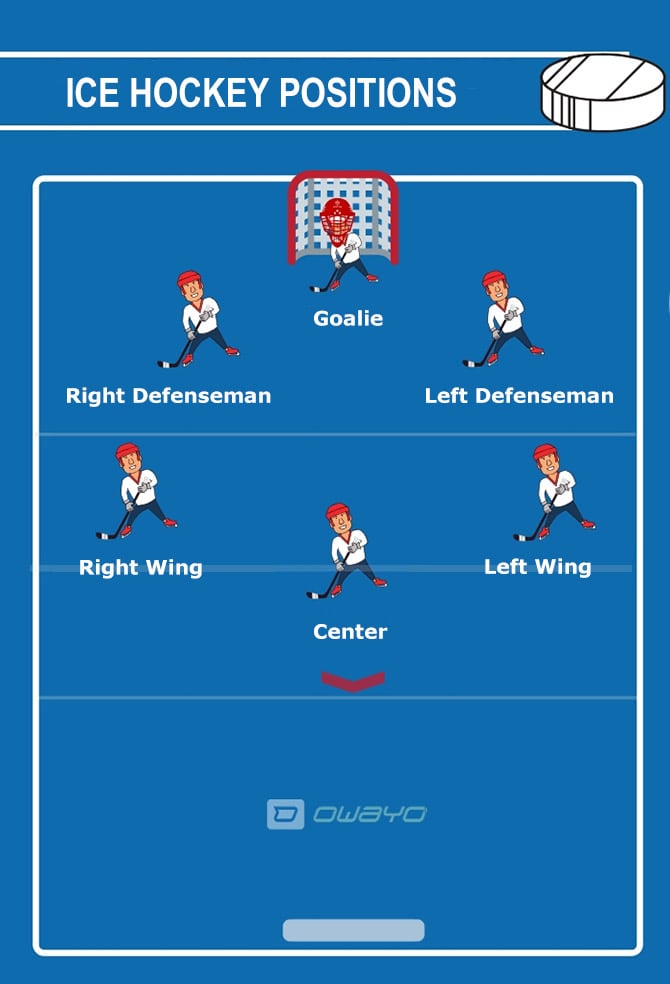In a standard hockey team, there are six players on the ice. This includes one goalie and five skaters.
Hockey is a fast-paced, thrilling sport enjoyed worldwide. Understanding the team structure is key for fans and newcomers. Each player has a specific role, contributing to the team’s strategy and success. The goalie defends the net, while skaters work together to score goals and prevent the opposing team from scoring.
Knowing the number of players and their roles can enhance your appreciation of the game. Whether you’re watching or playing, this knowledge helps you follow the action more closely. Let’s dive deeper into the roles and responsibilities of each player in a hockey team.

Credit: www.owayo.com
Team Structure
The structure of a hockey team is both complex and fascinating. Each team consists of several players with specific roles and responsibilities. Understanding the team structure helps in appreciating the game’s dynamics. Let’s explore the key components of a hockey team.
Players On The Ice
A standard hockey team has six players on the ice during play. These include three forwards, two defensemen, and one goaltender. Forwards are responsible for scoring goals. They play in three positions: center, left wing, and right wing.
Defensemen protect their goal from opponents. They also help to advance the puck to forwards. The goaltender’s primary job is to stop the puck from entering the net. Each player on the ice has a crucial role. Together, they form a cohesive unit.
Bench Players
A hockey team also includes bench players. These players are substitutes who can replace those on the ice. Teams can have up to 20 players, including the goaltender. Bench players are ready to jump in at any moment.
Quick substitutions are common due to the fast pace of the game. Fresh players maintain high energy levels. Bench players must stay alert and prepared. They play an essential role in a team’s overall strategy.
Roles And Positions
Understanding the roles and positions in a hockey team is key to appreciating the game. Each player has a specific role that contributes to the team’s overall strategy and success. Let’s break down the main positions: forwards, defensemen, and the goaltender.
Forwards
Forwards are the primary attackers in a hockey team. They focus on scoring goals and creating offensive opportunities. There are three types of forwards:
- Center: The playmaker who controls the puck and sets up goals.
- Left Wing: Positioned on the left side, supporting the center.
- Right Wing: Positioned on the right side, balancing the attack.
Forwards need speed and agility. They must be able to skate quickly and handle the puck skillfully.
Defensemen
Defensemen focus on stopping the opposing team’s forwards. They protect their goaltender and clear the puck from their zone. There are two types of defensemen:
- Left Defense: Positioned on the left side, supporting the left wing.
- Right Defense: Positioned on the right side, supporting the right wing.
Defensemen need strength and tactical awareness. They must anticipate the opponent’s moves and block shots.
Goaltender
The goaltender, or goalie, is the last line of defense. Their primary role is to stop the puck from entering the net. They must be agile, focused, and have quick reflexes.
Goaltenders often wear specialized equipment to protect themselves from high-speed pucks. Their equipment includes:
- Helmet with cage or shield
- Chest protector
- Leg pads
- Gloves
- Stick
Each position in hockey is vital. Together, they form a cohesive unit that works towards winning the game.
Substitution Rules
Substitution rules in hockey are unique. They add a dynamic element to the game. Players can switch at almost any time. This helps keep the game fast and exciting. Understanding these rules is crucial for fans and players alike. Let’s delve into the specifics.
On-the-fly Changes
On-the-fly changes mean players can switch without stopping the game. This keeps the action continuous. Each team can have six players on the ice. This includes the goalie. Quick changes ensure fresh players are always ready. Coaches plan these changes to maintain high energy levels. Skaters must watch their timing and positioning. Incorrect changes can lead to penalties.
Penalty Situations
During penalties, substitution rules change. The penalized team has fewer players. This is called being short-handed. Usually, they play with four skaters instead of five. The other team gets a power play. They have a higher chance to score. Coaches use specific players for these situations. These players excel in defense or scoring. Substitutions must be quick and strategic. This maximizes the team’s advantage or minimizes their disadvantage.
Special Teams
In hockey, special teams play a crucial role. These units handle situations when a team has more or fewer players due to penalties. Knowing how these teams operate can help you understand the game better.
Power Play Unit
The power play unit comes into play when the opposing team has a player in the penalty box. This unit usually consists of five players:
- Three forwards
- Two defensemen
Sometimes, teams use four forwards and one defenseman for a more aggressive approach. The goal is to use the extra player to score. They often position players close to the net. Quick passes and constant movement are key strategies.
Penalty Kill Unit
The penalty kill unit is the opposite. This unit comes into play when the team is short-handed due to a penalty. The main goal is to prevent the opposing team from scoring. The typical setup includes:
- Two forwards
- Two defensemen
The forwards focus on blocking shots and clearing the puck out of their zone. Defensemen stay closer to their goalie to block shots. Quick shifts and strong communication are essential.
Team Composition In Different Leagues
The composition of hockey teams varies across different leagues. Each league has its own rules and regulations. Understanding these differences helps fans appreciate the sport more.
Nhl Teams
In the National Hockey League (NHL), each team has 23 players. This roster includes 20 active players and 3 healthy scratches. The active players consist of 12 forwards, 6 defensemen, and 2 goalies. Coaches decide which players will play in each game. They can rotate players based on performance and strategy.
International Teams
International hockey teams, such as those in the Olympics, have different rules. Teams usually have 20 to 22 players. This includes 2 or 3 goalies. The rest are forwards and defensemen. The exact number can vary by tournament. Coaches often select the best players from their country. This makes international games exciting and competitive.

Credit: www.polyglidesyntheticice.com

Credit: medium.com
Frequently Asked Questions
How Many Players Are On A Hockey Team?
A hockey team has six players on the ice during a game.
What Positions Do Hockey Players Play?
Hockey players have five main positions: forward, defenseman, and goalie.
How Many Forwards Are In A Hockey Team?
There are usually three forwards on the ice: left wing, center, and right wing.
How Many Defensemen Are In A Hockey Team?
A team typically has two defensemen on the ice.
How Many Goalies Are On A Hockey Team?
Each team has one goalie on the ice.
How Many Players Are On A Hockey Roster?
A standard hockey roster includes 20 players.
Are There Substitutes In Hockey?
Yes, teams have substitutes who can replace players during the game.
How Many Lines Are In A Hockey Team?
Teams usually have four lines of forwards and three pairs of defensemen.
Can Players Change During A Hockey Game?
Yes, players can change lines during the game for rest or strategy.
Conclusion
A hockey team consists of six players on the ice. Each team has a goalie, two defensemen, and three forwards. Knowing the team structure helps understand the game better. It enhances your viewing experience. Whether watching or playing, this knowledge is vital.
Enjoy the dynamic and fast-paced world of hockey. Explore more about positions and roles. This way, you will appreciate the strategy involved. Stay curious, and keep learning about this exciting sport.




